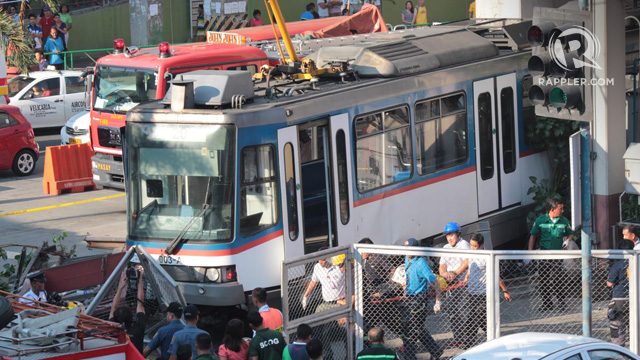SUMMARY
This is AI generated summarization, which may have errors. For context, always refer to the full article.

MANILA, Philippines – Around 4 “service interruptions” monthly; non-functioning elevators, escalators, and ticket dispensers; and an “obsolete” signalling system.
Welcome to Metro Rail Transit 3 (MRT3), one of Metro Manila’s main mass transit lines.
“How did we reach this point? Bakit hindi natin natugunan kaagad (Why didn’t we address this right away)?” Senator Benigno Aquino IV asked officials of the Department of Transportation and Communications (DOTC) during a Senate hearing on Monday, September 1.
The answer to that question was complicated. There were delays in upgrades, legal issues over ownership and contracts, and a flawed public-private partnership (PPP) projects, the officials said.
“Obviously MRT3 is not a good example of a good PPP,” said Aquino, referring to one of the administration’s flagship programs, the public-private partnerships on major infrastractures.
“Unfortunately, it’s not,” DOTC Undersecretary for Legal and Procurement Jose Perpetuo Lotilla acknowledged.
The stakes are high for the DOTC and the MRT3, which is currently running beyond its designed capacity of 360,000 passengers a day and “crush capacity” of half a million passengers daily. Close to 600,000 passengers ride the MRT 3 daily and the numbers are sure to balloon.
In the next 5 years, around 800,000 passengers will be riding the train line daily; by 2015, it would be 1.2 million passengers.
‘I rode your train, and…’
The hearing, chaired by Senator Grace Poe, was prompted by the derailing of an MRT3 train on August 13, which injured at least 36 people. Poe is also the sponsor of a bill that seeks to create a National Transport Safety Board.
During the hearing, Poe urged DOTC Secretary Joseph Emilio Abaya and other transport officials to “show concern” for Metro Manila commuters. Technical glitches, long lines, and reports of human error in operations are persistent problems of the train line.

Poe herself rode the MRT3 on Friday, days ahead of the hearing. The senator, who rode end-to-end from the North Avenue station in Quezon city to the Taft station in Pasay City duringn rush hour, was not spared from the daily woes of regular commuters.
“I rode your train. Even the communication system is not clear. You wouldn’t know if there’s an emergency of if it’s already your stop,” noted Poe.
The senator proposed that the DOTC issue vouchers for passengers forced to disembark due to operational glitches, deploy “MRT buses” to accommodate displaced passengers, and provide umbrellas for those lining up outside stations.
“This is part of the services, hindi p’wedeng TY na lang, na sorry bumaba na lang kayo…. Ipakita naman ninyo sa kanila na habang wala ang ipinapangakong mga tren, meron tayong ginagawa. Gusto ko lamang makita ng taumbayan na may malasakit ang gobyerno natin,” said Poe.
(You can’t just say, ‘Thank you, sorry, you have to go down here.’ While we’re waiting for the 48 new cars, you have to show commuters that you’re doing something. The people want to see that the government cares.)
Glitches mount
Data from the MRT3 itself paint a bleak picture of the line, supporting the complaints of commuters.
The MRT3 reported an increase of average service interruptions per month from 1.83/month in 2008 to 2.42/month in 2011 to 4 a month during the first 7 months of 2014.
The train line is operated by the DOTC itself while its maintenance is outsourced to a private company. The maintenance operator of the MRT was Sumimoto Corporation from December 1999 to October 2012. After that, PH Trams-CB&T took over for 10 and a half months from October 20, 2012 to September 4, 2013.
The current maintenance provider, Global-APT, took over on September 5, 2013. Its contract is due to expire by September 4 this year.
At least 15% of escalators in train stations and 34% of elevators are not operational, while none of the train line’s ticket issuing machines are still working. Officials said the elevators and escalators could not be fixed because they were already “obsolete.” He added maintenance providers are now unable to look for spare parts.
The result? An average waiting time of 30-45 minutes, around the same time it takes a train to travel from end-to-end.
MRT3 director Renato San Jose said the goal is to cut down waiting time to 10 minutes – but that can only happen by the end of 2016, when all of the MRT3’s proposed projects are expected to be rolled out.
“In short, sorry na lang muna (we’ll just say sorry). Forty minutes talaga ang waiting time (waiting time will still be 40 minutes),” Senator Aquino concluded.c
Future proof?
At least 20 trains – or 60 train cars – should be deployed during rush hour.
For every decommissioned car, and non-functioning equipment, Global APT pays the government fines. LRTA administrator and MRT3 office-in-charge Honorario Chaleco said Global APT has incurred at least P19 million in fines so far, excluding July and August 2014.
The DOTC has at least 17 proposed rehabilitation programs for the MRT3, amounting to over P6.85 billion. The biggest among the projects are the acquisition of 48 train carts for the line at the cost of around P3.76 billion pesos, followed by a P1.16 billion for “train general overhauling.”
In an interview after the hearing, Abaya said the 48 trains should be able to sustain the train line “up to the early 2020s.”
But, he said, the projections do not take into account “suppressed demand.”

“Wala pa akong nakikita (I haven’t seen data) on suppressed demand. All of us here, if there are additional trains, we’d take the MRT3,” he said. Abaya had taken the MRT, but was heavily criticized for the media stunt.
Senator Juan Edgardo Angara, at the start of the hearing, urged the DOTC to take a “holistic” approach to its planning. “Sana merong holistic plan, which covers all aspects of transportation. Hindi lamang sa rail transit, bus transit, pati na rin ang bisikleta actually,” he said.
(I hope we have a holistic plan which covers all aspects of transportation. Not just rail transit or bus transit but even bicycles.) – Rappler.com
Add a comment
How does this make you feel?
There are no comments yet. Add your comment to start the conversation.